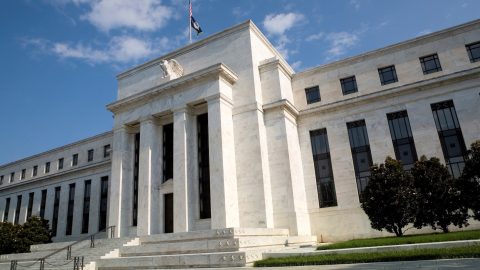You need a mixture of history, economics and politics to hear through the everyday noise and recognize the big trends of the future. In a new series “Longterm Outlook” the investment team of Erste AM deals with the topic of digitalization & industry 4.0.
You can find our other articles here: The next 10 years , Industry 4.0
When the economy is well, people are well. But just how well is the economy going to be in the coming years? Some economists believe the idea that we will be entering a secular stagnation – or have already entered it – to be a realistic scenario. What does that mean?
A secular stagnation is characterised by a long-term (secular, derived from the Latin “saeculum” – century, lifetime) low-level rate of economic growth (stagnation). Under normal circumstances, central banks would cut interest rates during recessions or periods of low economic growth so as to make it more appealing for companies to raise capital for investment purposes. That is not possible in a secular stagnation.
When the key-lending rates are already very low, they cannot be cut any further – at least not by any significant degree. This leads to the seemingly paradoxical situation of key-lending rates being still too high to generate a trend reversal at zero percent. As a result, interest rates remain sustainably low without inducing any form of long-term economic stimulus.
10Y government bond yields adjusted for inflation

Sources: Bloomberg, EAM
Why do companies invest so little?
There are a few reasons. Low or indeed negative population growth causes aggregate demand and thus the need for investments to decline. This means that investments yield a lower return. Also, productivity growth has been falling for years in the OECD states. This may come as a surprise, given the noticeable technical progress, but history shows that technological progress often takes years or even decades to arrive across the entire economy.
In addition, some progress is not reflected in the GDP or the bottom line of companies. Just think of the numerous free digital services. And finally, some industries have seen a significant degree of concentration in recent decades. The more power companies have on the market, the less they need to invest to stay competitive.
Productivity growth in the USA? and the Eurozone?

Source: OECD. Risk note: Past performance is not a reliable indicator of the future performance.
What can be done?
Monetary policy reaches its limits when it comes to a secular stagnation. In a cashless society it would theoretically be possible to cut interest rates significantly below zero, which would then make investments with a low expected return profitable as well. However, while this option has been discussed by economists, it will probably remain a theory in the foreseeable future. Another option – in fact, one that is already in use – is to reduce the credit risk premiums, i.e. spreads, through purchase programmes for securities from the central banks. This, too, makes capital cheaper for companies.
On the downside for investors, the yield on the various markets has been on the decline. Also, the limited usefulness of this strategy comes with its own set of risks. The valuation, i.e. the ratio of return to risk, rises, and the asset becomes more expensive. This means that the risk of drastic overvaluation (i.e. bubbles) rises as well. This tendency also reinforces inequalities in society, because those who already have a lot of wealth benefit most. Central banks therefore have to use this tool very carefully so as not to cause more damage than good.
A stronger role for fiscal policy would lend itself as an alternative to monetary policy. State investments in, for example, infrastructure (not the least in the context of climate change) could partially make up for the lack in demand from private households and the corporate sector. In addition, such investments could also boost the rate of return for private investments. Economic institutions such as the IMF – formerly not known to support demand-side economics – have realised the importance of a stronger role of the state. Given the current record level of debt it remains to be seen whether politicians will choose to go down that road.
Conclusion
The above-described case of a secular stagnation is not only a theoretical one. The prime example of an economy that has been caught in such a situation for years is Japan. The main characteristics of a secular stagnation are all there: low population growth, low economic growth, low interest rates, low inflation; and generally low rates of return on the capital markets. Europe seems to be heading for a similar scenario, and the USA appears to be close.
On the whole, the situation has probably deteriorated further in the wake of COVID-19, despite the positive aspects of a stepped-up acceleration of the digitalisation process. Trends such as falling population growth will be hard to reverse for a long time, much like the powerlessness of the central banks. We will see whether the Japan scenario can be averted in the medium term. If at all, it is most likely to work on the back of increased competition, fewer inequalities in society, and a paradigm shift towards a significantly more important role of state-sponsored investments.
Legal note:
Prognoses are no reliable indicator for future performance.
Legal disclaimer
This document is an advertisement. Unless indicated otherwise, source: Erste Asset Management GmbH. The language of communication of the sales offices is German and the languages of communication of the Management Company also include English.
The prospectus for UCITS funds (including any amendments) is prepared and published in accordance with the provisions of the InvFG 2011 as amended. Information for Investors pursuant to § 21 AIFMG is prepared for the alternative investment funds (AIF) administered by Erste Asset Management GmbH pursuant to the provisions of the AIFMG in conjunction with the InvFG 2011.
The currently valid versions of the prospectus, the Information for Investors pursuant to § 21 AIFMG, and the key information document can be found on the website www.erste-am.com under “Mandatory publications” and can be obtained free of charge by interested investors at the offices of the Management Company and at the offices of the depositary bank. The exact date of the most recent publication of the prospectus, the languages in which the key information document is available, and any other locations where the documents can be obtained are indicated on the website www.erste-am.com. A summary of the investor rights is available in German and English on the website www.erste-am.com/investor-rights and can also be obtained from the Management Company.
The Management Company can decide to suspend the provisions it has taken for the sale of unit certificates in other countries in accordance with the regulatory requirements.
Note: You are about to purchase a product that may be difficult to understand. We recommend that you read the indicated fund documents before making an investment decision. In addition to the locations listed above, you can obtain these documents free of charge at the offices of the referring Sparkassen bank and the offices of Erste Bank der oesterreichischen Sparkassen AG. You can also access these documents electronically at www.erste-am.com.
N.B.: The performance scenarios listed in the key information document are based on a calculation method that is specified in an EU regulation. The future market development cannot be accurately predicted. The depicted performance scenarios merely present potential earnings, but are based on the earnings in the recent past. The actual earnings may be lower than indicated. Our analyses and conclusions are general in nature and do not take into account the individual characteristics of our investors in terms of earnings, taxation, experience and knowledge, investment objective, financial position, capacity for loss, and risk tolerance.
Please note: Past performance is not a reliable indicator of the future performance of a fund. Investments in securities entail risks in addition to the opportunities presented here. The value of units and their earnings can rise and fall. Changes in exchange rates can also have a positive or negative effect on the value of an investment. For this reason, you may receive less than your originally invested amount when you redeem your units. Persons who are interested in purchasing units in investment funds are advised to read the current fund prospectus(es) and the Information for Investors pursuant to § 21 AIFMG, especially the risk notices they contain, before making an investment decision. If the fund currency is different than the investor’s home currency, changes in the relevant exchange rate can positively or negatively influence the value of the investment and the amount of the costs associated with the fund in the home currency.
We are not permitted to directly or indirectly offer, sell, transfer, or deliver this financial product to natural or legal persons whose place of residence or domicile is located in a country where this is legally prohibited. In this case, we may not provide any product information, either.
Please consult the corresponding information in the fund prospectus and the Information for Investors pursuant to § 21 AIFMG for restrictions on the sale of the fund to American or Russian citizens.
It is expressly noted that this communication does not provide any investment recommendations, but only expresses our current market assessment. Thus, this communication is not a substitute for investment advice, does not take into account the legal regulations aimed at promoting the independence of financial analyses, and is not subject to a prohibition on trading following the distribution of financial analyses.
This document does not represent a sales activity of the Management Company and therefore may not be construed as an offer for the purchase or sale of financial or investment instruments.
Erste Asset Management GmbH is affiliated with the referring Sparkassen banks and Erste Bank.
Please also read the “Information about us and our securities services” published by your bank.
Subject to misprints and errors.


